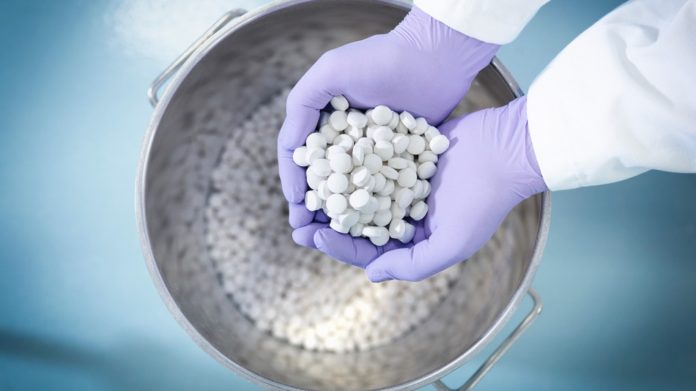What do the first 3D-printed pills mean for the future of drug companies?

Earlier this month, the U.S. Food and Drug Administration approved the first 3D-printed pill: Spritam levetiracetam, a drug which can reduce seizures among epileptics. Manufactured by the American pharmaceutical company Aprecia, it’s produced not by a tableting machine, but by a special process where the drug’s active and inactive ingredients are laid down layer-by-layer.
This unusual manufacturing technique helps Spritam’s patients in particular. By building each dose individually, Aprecia says it can make each pill more porous and more potent than more traditional techniques would allow. Pills printed through the company’s special process “disintegrate in less than 10 seconds,” it says, which is unusually quick for a high-dose drug. Experts say that doctors have historically struggled to give epileptics reliable pills in the right dosages.
Aprecia has now become the first major pharmaceutical company to print drugs. That means it now owns key intellectual property governing its own (presumably successful) version of the technique. Spritam’s website brags that Aprecia now holds more than 50 patents protecting its own 3D printing technique and 3D-printed pharmaceuticals in general. These patents will help it maintain a competitive advantage until 2033, it says.
It’s likely that other drugs will be found that, like Spritam, are made more effective by the process. By creating a structurally sound tablet from the top, a manufacturer will be able to do something medically important that it could not do otherwise.
It’s less clear, however, whether 3D printing will be able to change the drug industry in quite the way this technology is predicted to shape other fields. The usual story goes like this: Three-dimensional printing, by virtue of extruding plastic or metal at a small scale, permits a kind of localized, personalized production. That production might still be mass, for sure, but it’s mass-distributed, a kind of mass production where everyone gets their own special snowflake — or their own unique piece of jewelry.
This storyline shapes the conversation about Spritam and other possible 3D-printed drugs. “For the last 50 years, we have manufactured tablets in factories and shipped them to hospitals,” a pharmaceutical lecturer tells The Guardian. “For the first time, this process means we can produce tablets much closer to the patient.”
But I can’t tell whether this kind of democratization is Aprecia’s goal. The company hasn’t seemed to specify whether it plans to place its 3D printers in doctors’s offices or hospitals. Aprecia could very well place all of them in a couple factories, where it will print to common dosages on-demand. That would produce no real change from current practice. (Aprecia did not respond to multiple requests for comment.)
But if Aprecia does manage to move the drug-manufacturing process closer to the patient, it will buck more than a general trend toward centralization and mass production. Drug manufacturers have tended to consolidate not only over the past 100 years but also over the past couple decades, says Gregory Higby, a University of Wisconsin professor and the executive director of the American Institute of the History of Pharmacy. This corporate consolidation especially accelerated during the 1990s, he told me.
Higby said he didn’t know the specifics of Aprecia’s aspirations, but that the technique reminded him of an older paradigm.
“They sound like a return to the days of pharmacy compounding except that a machine is producing the pills instead of a pharmacist. In other words, 100 years ago, any pharmacist could mix together active and inactive ingredients to the specific strength prescribed by a physician for a patient. Now, you apparently tell the ‘printer’ to do it,” he said.
“Some entity still has to produce the drug — the active ingredient in the printer — and that will continue to be controlled by large manufacturers. Only they can afford the costs of getting a new drug approved by the FDA,” he added.
As for generics, he said he couldn’t see why a hospital would choose to replace “small bottles, the size of large peanut-butter containers, with a whole bunch of drug ‘printers.'”
“Some other technology will push this aside,” he added. “We don’t have bookstores with on-demand book-printing machines, which do exist; we have Amazon and Kindles.” (On-demand book printers do exist in some cities, but they have never escaped novelty status.)
Far more likely to affect the true future of drugs, he said, are pharmacy benefit managers, the enormous corporations who negotiate between drug companies and individual health insurers.
“The future of any pharmacy innovation,” Higby told me, “will be influenced by these middlemen.”

